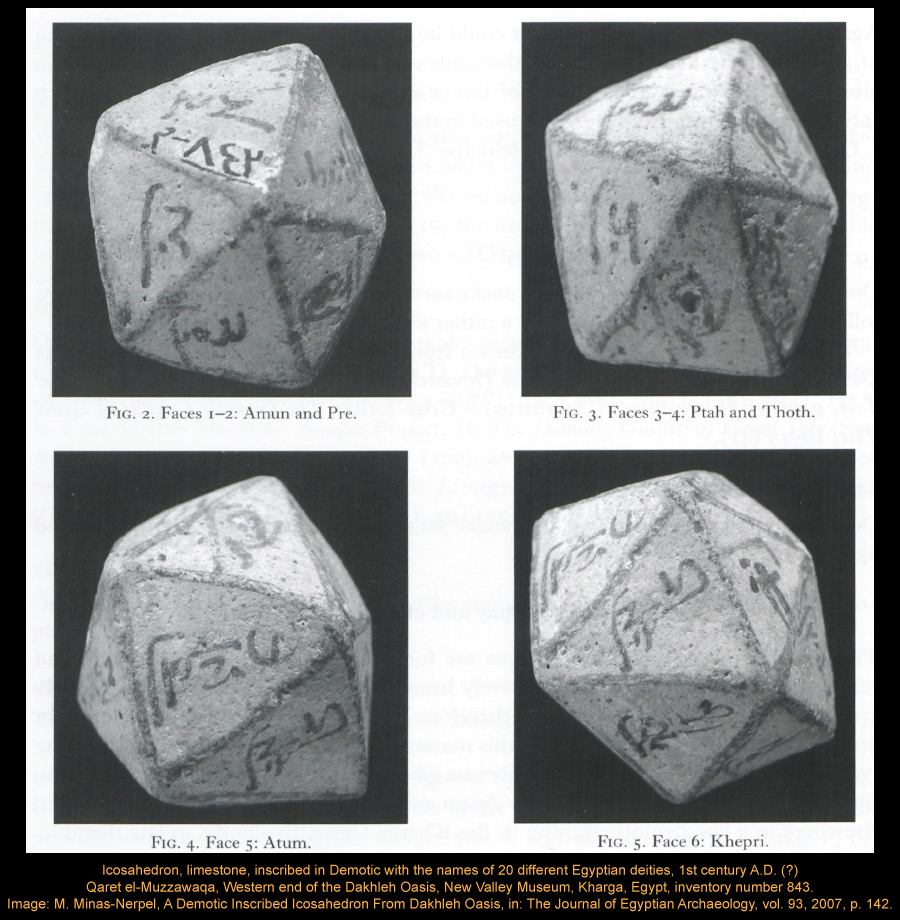Overview
This so far unique dice was made of limestone. Instead of numbers it was inscribed with the names of 20 different Egyptian deities. These names were written with black ink in Egyptian-Demotic. The edges of each triangular side were also marked with the ink.
A 20-sided dice is called icosahedron, from ancient Greek εἴκοσι (eíkosi) = twenty and ἕδρα (hédra) = seat.
Findspot: Qaret el-Muzzawaqa, Western end of the Dakhleh Oasis
Location: New Valley Museum, Kharga, Egypt, inventory number 843
Date: 1st century A.D. (?)

The names of the deities
The names of the deities are:
- Amun
- Pre
- Ptah
- Thoth
- Atum
- Khepri
- Geb
- Osiris
- Horus
- Isis
- Bastet
- Hapy
- Triphis
- Shay (Agathos Daimon)
- Nephthys
- Neith
- Shepshit (Agathe Tyche)
- Min
- Khonsu
- Mut
Parallels
Due to the unique nature of the dice a definite interpretation is not possible, but there is plenty of archaeological as well as textual evidence for the use of dice in oracular and divinatory contexts, but these are usually dice with numbers, for example the Homer oracle at the beginning of the Greek ritual manual PGM VII. A late source from the corpus of the Greek magical papyri seems to refer to a dice inscribed with Tyche and Daimon:
The Greek ritual manual PGM L, 1-18 (6th century) is only preserved fragmentarily, it reads:
“and if their principal (lots ?) should [fall] on the side of [the lots] of ‘”Tyche” or “Daimon” [it is good ?] for a spell (?) concerning sorcery / – the same principal (tosses?) of the lot producing the same result, with a “Tyche” or “Daimon” being an excellent toss. And the one who tosses concerning sorcery. . .
executes the same given results for the given toss. (…)”
Translation: Roy Kotansky, in Betz (ed), The Greek Magical Papyri in Translation (1986), 283.
Here it seems that the ritual serves to either find out the right deity for a ritual, the right ritual purpose for the moment, or if a ritual for a certain purpose would be successful.
A divination ritual with 29 names of deities inscribed on date palm leaves is preserved in the Greek ritual manual PGM XXIVa., 1-25 (3rd/4th century):
“Great is the Lady Isis!” Copy of a holy book found in the archives of Hermes: The method is that concerning the 29 letters through which letters Hermes and Isis, who was seeking Osiris, her brother and husband, [found him].
Call upon Helios and all the gods in the deep concerning those things for which you want to receive an omen. Take 29 leaves of a male date palm and write on each of the leaves the names of the gods. Pray and then pick them up two I by two. Read the last remaining leaf and you will find your omen, how things are, and you will be answered clearly.”
Translation: W. C. Grese, in Betz (ed), The Greek Magical Papyri in Translation (1986), 264.
Interpretation
This shows that the idea of writing down a selection of names of deities for oracular or divinatory purposes did exist in ancient ritual practice. The 20-sided dice inscribed with the names of 20 Egyptian deities is very likely to derive from a similar context. Due to the large number of deities there are several potential ways in which the dice could have been used, for example:
- each deity stood for a specific kind of ritual or ritual purpose to be conducted best at the time the dice was cast;
- the cast deity represented the deity the practitioner had to address in an upcoming ritual;
- each deity represented a specific answer to a question.
In all of these cases it seems likely that the owner of the dice had a papyrus at hand which contained the information referring to each deity.
